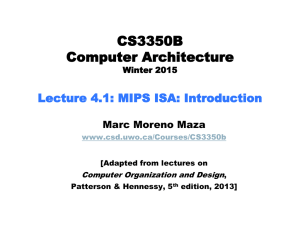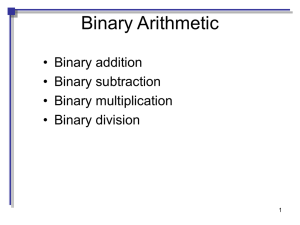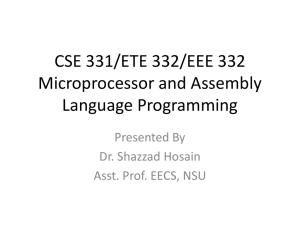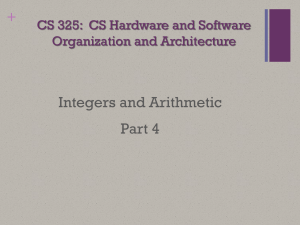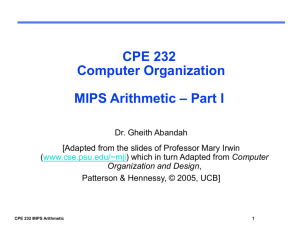Number Representation - Kastner Research Group
advertisement
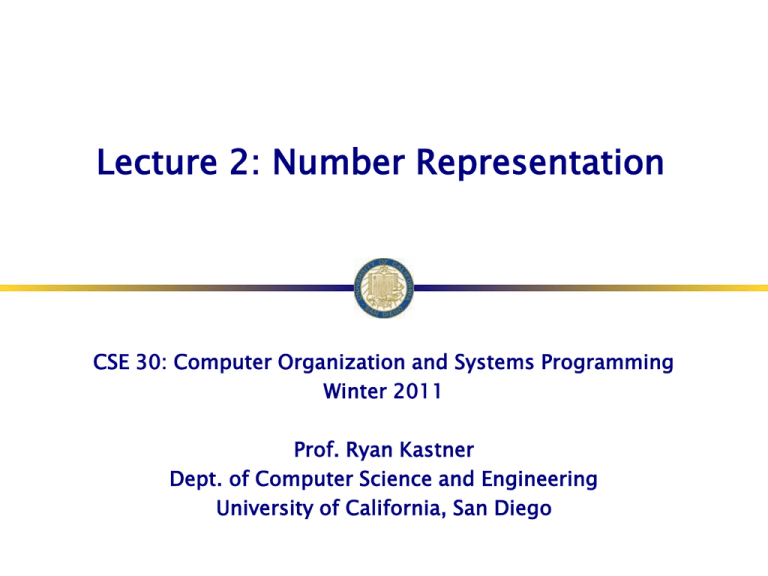
Lecture 2: Number Representation CSE 30: Computer Organization and Systems Programming Winter 2011 Prof. Ryan Kastner Dept. of Computer Science and Engineering University of California, San Diego Decimal Numbers: Base 10 Digits: 0, 1, 2, 3, 4, 5, 6, 7, 8, 9 Example: 3271 = (3x103) + (2x102) + (7x101) + (1x100) Numbers: Positional Notation Number Base B B symbols per digit: Base 10 (Decimal): Base 2 (Binary): 0, 1, 2, 3, 4, 5, 6, 7, 8, 9 0, 1 Number representation: d31d30 ... d1d0 is a 32 digit number value = d31 B31 + d30 B30 + ... + d1 B1 + d0 B0 Binary: 0,1 (In binary digits called “bits”) = 124 + 123 + 022 + 121 + 020 = 16 + 8 + 2 #s often written = 26 0b… Here 5 digit binary # turns into a 2 digit decimal # Can we find a base that converts to binary easily? 0b11010 Hexadecimal Numbers: Base 16 Hexadecimal: 0, 1, 2, 3, 4, 5, 6, 7, 8, 9, A, B, C, D, E, F Normal digits + 6 more from the alphabet In C, written as 0x… (e.g., 0xFAB5) Conversion: BinaryHex 1 hex digit represents 16 decimal values 4 binary digits represent 16 decimal values 1 hex digit replaces 4 binary digits One hex digit is a “nibble”. Two is a “byte” 2 bits is a “half-nibble”. Shave and a haircut… Example: 1010 1100 0011 (binary) = 0x_____ ? Decimal vs. Hexadecimal vs. Binary Examples: Examples: 1010 (binary) 10101100 11000011 0011 (binary) = 0xAC3 = 0xAC3 10111 10111(binary) (binary) = 0001 0111 (binary) = 0001 0111 (binary) = 0x17 = 0x17 0x3F9 0x3F9 = 11 1111 1001 (binary) = 11 1111 1001 (binary) How do we convert between hex HowDecimal? do we convert between hex and and Decimal? 00 01 02 03 04 05 06 07 08 09 10 11 12 13 14 15 0 1 2 3 4 5 6 7 8 9 A B C D E F MEMORIZE! 0000 0001 0010 0011 0100 0101 0110 0111 1000 1001 1010 1011 1100 1101 1110 1111 Which base do we use? Decimal: great for humans, especially when doing arithmetic Hex: if human looking at long strings of binary numbers, its much easier to convert to hex and look 4 bits/symbol Terrible for arithmetic on paper Binary: what computers use; you will learn how computers do +, -, *, / To a computer, numbers always binary Regardless of how number is written: 32ten == 3210 == 0x20 == 1000002 == 0b100000 Use subscripts “ten”, “hex”, “two” in book, slides when might be confusing What to do with representations of numbers? Just what we do with numbers! 1 Add them Subtract them Multiply them Divide them Compare them Example: 10 + 7 = 17 + 1 1 0 1 0 0 1 1 1 ------------------------- 1 0 0 0 1 …so simple to add in binary that we can build circuits to do it! subtraction just as you would in decimal Comparison: How do you tell if X > Y ? BIG IDEA: Bits can represent anything!! Characters? 26 letters 5 bits (25 = 32) upper/lower case + punctuation 7 bits (in 8) (“ASCII”) standard code to cover all the world’s languages 8,16,32 bits (“Unicode”) www.unicode.com Logical values? 0 False, 1 True colors ? Ex: locations / addresses? commands? MEMORIZE: N bits at most 2N things Red (00) Green (01) Blue (11) How to Represent Negative Numbers? So far, unsigned numbers Obvious solution: define leftmost bit to be sign! 0 +, 1 – Rest of bits can be numerical value of number Representation called sign and magnitude MIPS uses 32-bit integers. +1ten would be: 0000 0000 0000 0000 0000 0000 0000 0001 And –1ten in sign and magnitude would be: 1000 0000 0000 0000 0000 0000 0000 0001 Shortcomings of sign and magnitude? Arithmetic Special circuit complicated steps depending whether signs are the same or not Also, two zeros 0x00000000 = +0ten 0x80000000 = –0ten What would two 0s mean for programming? Therefore sign and magnitude abandoned Another try: complement the bits 710 = 001112 –710 = 110002 Called One’s Complement Note: positive numbers have leading 0s, negative numbers have leadings 1s. Example: 00000 00001 ... 01111 10000 ... 11110 11111 • What is -00000 ? Answer: 11111 • How many positive numbers in N bits? • How many negative numbers? Shortcomings of One’s complement? Arithmetic still a somewhat complicated. Still two zeros 0x00000000 = +0ten 0xFFFFFFFF = -0ten Although used for awhile on some computer products, one’s complement was eventually abandoned because another solution was better. Standard Negative Number Representation What is result for unsigned numbers if tried to subtract large number from a small one? Would try to borrow from string of leading 0s, so result would have a string of leading 1s 3 - 4 00…0011 – 00…0100 = 11…1111 With no obvious better alternative, pick representation that made the hardware simple As with sign and magnitude, leading 0s positive, leading 1s negative 000000...xxx is ≥ 0, 111111...xxx is < 0 except 1…1111 is -1, not -0 (as in sign & mag.) This representation is Two’s Complement 2’s Complement Number “line”: N = 5 00000 00001 11111 11110 00010 -1 0 1 11101 2 -2 -3 11100 -4 . . . . . . 2N-1 nonnegatives 2N-1 negatives one zero how many positives? -15 -16 15 10001 10000 01111 10000 ... 11110 11111 00000 00001 ... 01111 Two’s Complement Formula Can represent positive and negative numbers in terms of the bit value times a power of 2: d31 x -(231) + d30 x 230 + ... + d2 x 22 + d1 x 21 + d0 x 20 Example: 1101two = 1x-(23) + 1x22 + 0x21 + 1x20 = -23 + 22 + 0 + 20 = -8 + 4 + 0 + 1 = -8 + 5 = -3ten Two’s Complement shortcut: Negation Change every 0 to 1 and 1 to 0 (invert or complement), then add 1 to the result Proof*: Sum of number and its (one’s) complement must be 111...111two However, 111...111two= -1ten Let x’ one’s complement representation of x Then x + x’ = -1 x + x’ + 1 = 0 -x = x’ + 1 Example: -3 to +3 to -3 x : 1111 1111 1111 1111 1111 1111 1111 1101two x’: 0000 0000 0000 0000 0000 0000 0000 0010two +1: 0000 0000 0000 0000 0000 0000 0000 0011two ()’: 1111 1111 1111 1111 1111 1111 1111 1100two +1: 1111 1111 1111 1111 1111 1111 1111 1101two You should be able to do this in your head… Two’s Complement for N=32 0000 ... 0000 0000 0000 0000two = 0000 ... 0000 0000 0000 0001two = 0000 ... 0000 0000 0000 0010two = ... 0111 ... 1111 1111 1111 1101two = 0111 ... 1111 1111 1111 1110two = 0111 ... 1111 1111 1111 1111two = 1000 ... 0000 0000 0000 0000two = 1000 ... 0000 0000 0000 0001two = 1000 ... 0000 0000 0000 0010two = ... 1111 ... 1111 1111 1111 1101two = 1111 ... 1111 1111 1111 1110two = 1111 ... 1111 1111 1111 1111two = 0ten 1ten 2ten 2,147,483,645ten 2,147,483,646ten 2,147,483,647ten –2,147,483,648ten –2,147,483,647ten –2,147,483,646ten • One zero; 1st bit called sign bit • 1 “extra” negative:no positive 2,147,483,648ten –3ten –2ten –1ten Two’s comp. shortcut: Sign extension Convert 2’s complement number rep. using n bits to more than n bits Simply replicate the most significant bit (sign bit) of smaller to fill new bits 2’s comp. positive number has infinite 0s 2’s comp. negative number has infinite 1s Binary representation hides leading bits; sign extension restores some of them 16-bit -4ten to 32-bit: 1111 1111 1111 1100two 1111 1111 1111 1111 1111 1111 1111 1100two What if too big? Binary bit patterns above are simply representatives of numbers. Strictly speaking they are called “numerals”. Numbers really have an number of digits with almost all being same (00…0 or 11…1) except for a few of the rightmost digits Just don’t normally show leading digits If result of add (or -, *, / ) cannot be represented by these rightmost HW bits, overflow is said to have occurred. 11110 11111 00000 00001 00010 unsigned Question X = 1111 1111 1111 1111 1111 1111 1111 1100two Y = 0011 1011 1001 1010 1000 1010 0000 0000two A. B. C. X > Y (if signed) X > Y (if unsigned) Babylonians could represent ALL their integers from [-2N-1 to 2N-1] with N bits! 0: 1: 2: 3: 4: 5: 6: 7: ABC FFF FFT FTF FTT TFF TFT TTF TTT Signed vs. Unsigned Variables Java and C declare integers int Use Also, two’s complement (signed integer) C declaration unsigned int Declares a unsigned integer Treats 32-bit number as unsigned integer, so most significant bit is part of the number, not a sign bit Kilo, Mega, Giga, Tera, Peta, Exa, Zetta, Yotta physics.nist.gov/cuu/Units/binary.html Common use prefixes (all SI, except K [= k in SI]) Name Abbr Factor SI size Kilo K 210 = 1,024 103 = 1,000 Mega M 220 = 1,048,576 106 = 1,000,000 Giga G 230 = 1,073,741,824 109 = 1,000,000,000 Tera T 240 = 1,099,511,627,776 1012 = 1,000,000,000,000 Peta P 250 = 1,125,899,906,842,624 1015 = 1,000,000,000,000,000 Exa E 260 = 1,152,921,504,606,846,976 1018 = 1,000,000,000,000,000,000 Zetta Z 270 = 1,180,591,620,717,411,303,424 1021 = 1,000,000,000,000,000,000,000 Yotta Y 280 = 1,208,925,819,614,629,174,706,176 1024 = 1,000,000,000,000,000,000,000,000 Confusing! Common usage of “kilobyte” means 1024 bytes, but the “correct” SI value is 1000 bytes Hard Disk manufacturers & Telecommunications are the only computing groups that use SI factors, so what is advertised as a 30 GB drive will actually only hold about 28 x 230 bytes, and a 1 Mbit/s connection transfers 106 bps. kibi, mebi, gibi, tebi, pebi, exbi, zebi, yobi en.wikipedia.org/wiki/Binary_prefix New IEC Standard Prefixes [only to exbi officially] Name Ki 210 = 1,024 mebi Mi 220 = gibi Gi 230 = 1,073,741,824 tebi Ti 240 = 1,099,511,627,776 pebi Pi 250 = 1,125,899,906,842,624 exbi Ei 260 = 1,152,921,504,606,846,976 zebi Zi 270 = 1,180,591,620,717,411,303,424 yobi Yi 280 = 1,208,925,819,614,629,174,706,176 kibi Abbr Factor 1,048,576 As of this writing, this proposal has yet to gain widespread use… International Electrotechnical Commission (IEC) in 1999 introduced these to specify binary quantities. Names come from shortened versions of the original SI prefixes (same pronunciation) and bi is short for “binary”, but pronounced “bee” :-( Now SI prefixes only have their base-10 meaning and never have a base-2 meaning. The way to remember #s is 234? How many bits addresses (I.e., what’s ceil log2 = lg of) 2.5 TiB? Answer! 2XY means… What X=0 --X=1 kibi ~103 6 X=2 mebi ~109 X=3 gibi ~1012 X=4 tebi ~10 15 X=5 pebi ~1018 X=6 exbi ~1021 X=7 zebi ~10 24 X=8 yobi ~10 Y=0 1 Y=1 2 Y=2 4 Y=3 8 Y=4 16 Y=5 32 Y=6 64 Y=7 128 Y=8 256 Y=9 512 MEMORIZE! Summary We represent “things” in computers as particular bit patterns: N bits 2N things Decimal for human calculations, binary for computers, hex to write binary more easily 1’s complement - mostly abandoned 00000 00001 ... 01111 10000 ... 11110 11111 2’s complement universal in computing: cannot avoid, so learn 00000 00001 ... 01111 10000 ... 11110 11111 Overflow: numbers ; computers finite,errors!


